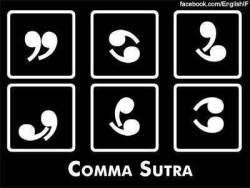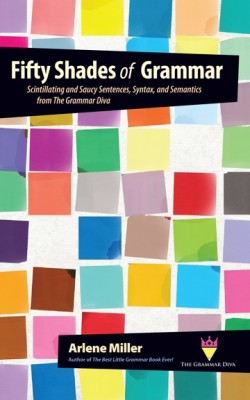 The turkey is almost gone, the stuffing a memory . . . time to resume talking about commas! Last time we talked about commas, we talked about using them to set off words that interrupted a sentence. Today, the topic is phrases that interrupt a sentence and when you use commas . . . and when you don’t.
The turkey is almost gone, the stuffing a memory . . . time to resume talking about commas! Last time we talked about commas, we talked about using them to set off words that interrupted a sentence. Today, the topic is phrases that interrupt a sentence and when you use commas . . . and when you don’t.
A phrase is a small group of words that belong together. They do not make a sentence. We will talk about using commas to set off these types of phrases: idiomatic, appositives, prepositional, and participial.
- Idiomatic phrase – I know, by the way, where you were last night.
- Appositive phrase – Dr. Caprone, my next door neighbor, is out of town for the summer.
- Prepositional phrase – The cat in the window is very cute.
- Participial phrase – The man, chasing his dog down the street, was unable to catch the dog until they had run five blocks.
Idiomatic phrases – Idioms are common sayings. Here are some phrases that are idioms: for example, in my opinion, by the way, as you know (which is actually a clause, but still an idiom). You would generally set these off in commas when they are in the middle of a sentence (and use a comma before them if they end the sentence).
- This dress, in my opinion, is better made than the other one.
- That movie, by the way, won nine Academy Awards.
- This test, as you know, counts for half your grade.
Appositive phrases – An appositive phrase generally describes a noun that comes right before it. An appositive phrase usually is set off in commas. As we said in the post that talked about interrupted words, a single word used as appositive is not always set in commas.
- Mr. Jamison, my math teacher, is really tough.
- My sister, a student at Boston University, is coming home for the holidays.
- The lead in the play, the girl with the bright red hair, is very talented.
- My brother Edward is the tallest member of the family. (If you have more than one brother, you need to identify which one, so Edward is necessary and is not set off.)
Prepositional phrases – Prepositional phrases tell where, when, or what kind and are made up of a preposition, sometimes an article, and then a noun or pronoun. Like an appositive phrases, a prepositional phrase often describes a noun that comes before it. You don’t use commas around prepositional phrases as a rule:
- The cat with the white spots is my newest pet.
- That blue suit in the window is the one we have chosen for the groom.
- The book on the table is due at the library.
Participial phrases – These phrases also describe a noun or pronoun in the sentence. They consist of a participle (a word that looks like a verb with an -ing ending or a past tense form) and words that go with it. Sometimes you set such a phrase off with commas and other times you don’t. It depends on whether or not the phrase is necessary to identify the noun it describes. Here are some examples.
- The boy running faster than the rest of the crowd is my classmate. (Which boy? If you need the phrase to identify him, do not use commas.)
- My mother, carefully putting on her makeup, is getting ready for a wedding. (You don’t need the phrase to identify your mother.)
- This game, missing some pieces, isn’t able to be played any more.
- That cat, sitting in the middle of the street, is in a dangerous spot.
- The cat sitting in the middle of the street belongs to my neighbor.
Can you go by the old rule of using commas when you would pause? Yes, that method of deciding actually works much of the time with these phrases. There is sometimes a fine line between using a comma and not — and it seems that it could go either way. Do the best you can in these cases. Grammar and punctuation is more of an art than a science!
Next week we will talk about adjective phrases and commas. I bet you can’t wait!
Fifty Shades of Grammar: Scintillating and Saucy Sentences, Syntax, and Semantics is now available. You can find it on Amazon and all other online retailers. Bookstores can order it from Ingram. You can also order it from your favorite brick and mortar bookstore, and Copperfields bookstores in Sonoma County will likely stock it — Petaluma definitely will.
Thank you for making The Best Grammar Workbook Ever an Amazon bestseller. I hope this book can follow in its footsteps.
Fifty Shades of Grammar is a collection of fifty of my blog posts. It is divided into eight sections: grammar, punctuation, words, writing, holidays, quizzes, random topics, and the “fifty shades” series of posts. Here are just some of the post titles included:
- Don’t Dangle Your Participles!
- Which. That. Who, Help!
- A Toast to the Semicolon
- Apostrophe Catastrophes
- Can You Spell These Words?
- There Is Nothing to Fear
- Five Tips for Great Writing: TOMAS
- The Seven Deadly Sins of Writing
- National Grammar Day Is March 4!
- Some Real Grammar Turkeys: Happy Thanksgiving!
- The Alien in Your Future (My Favorite Post)
- People Say the Darndest Things
- Fifty Shades of Grammar, Parts I, II, III, and Finale
Fifth Shades of Grammar would make a great holiday gift for your favorite word lover! Retail price is $15. It is 211 pages long.
I hope you all had a wonderful Thanksgiving, or at least a peaceful one.




This is awesome. Thank you! I will be covering this with my LA 9 classes tomorrow.
Great! Hope it goes well with the students — and thanks for the comment!